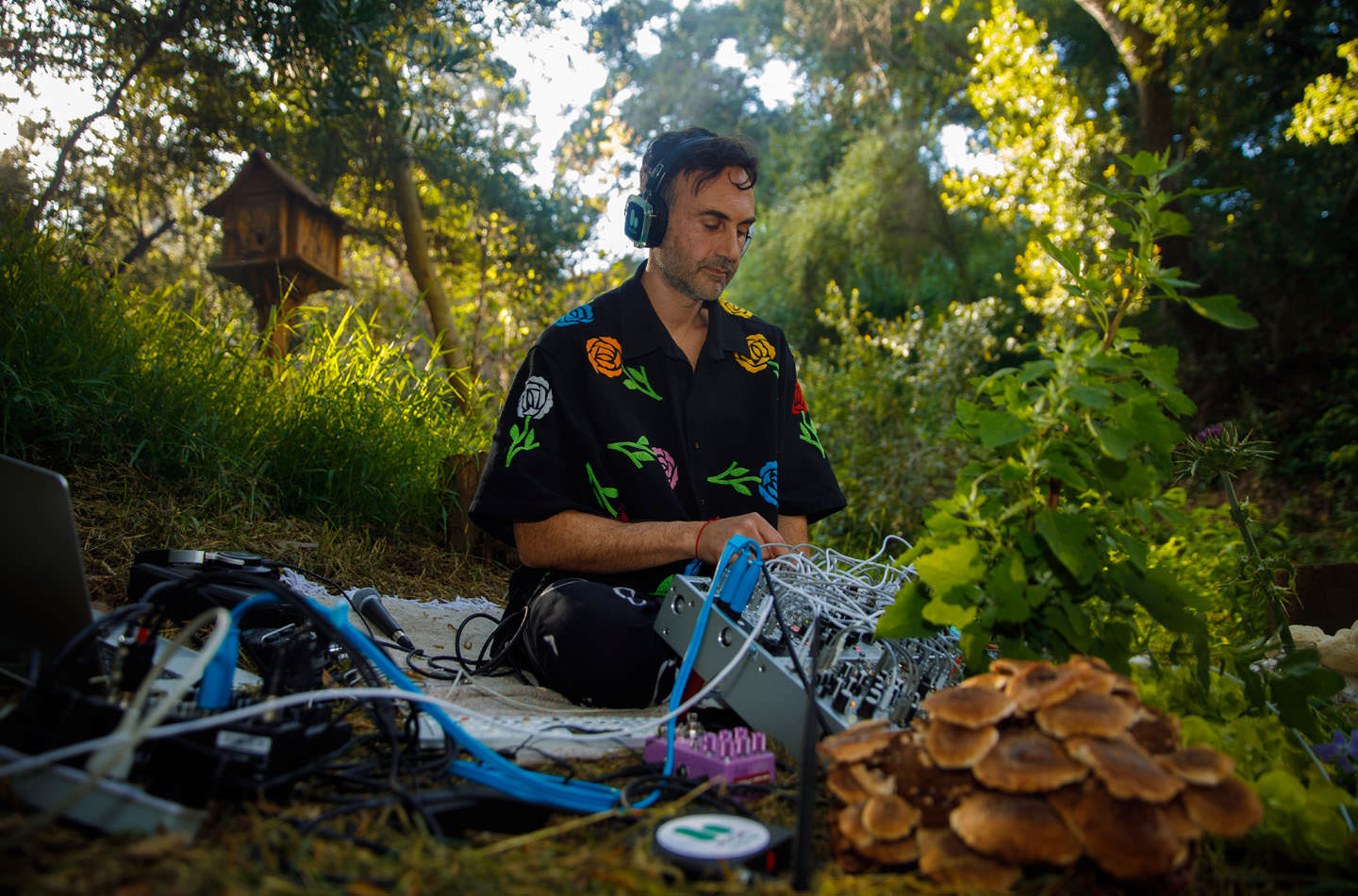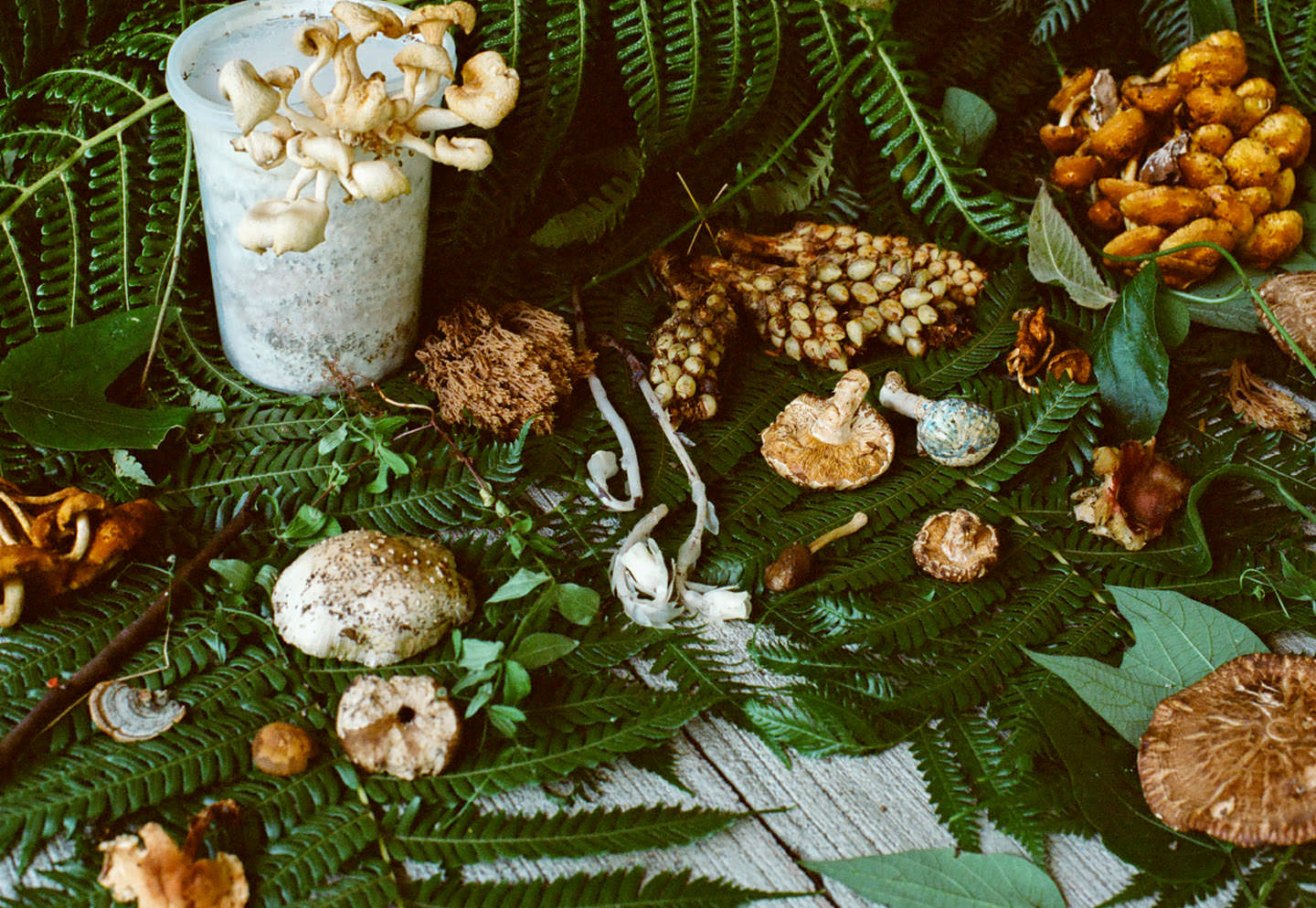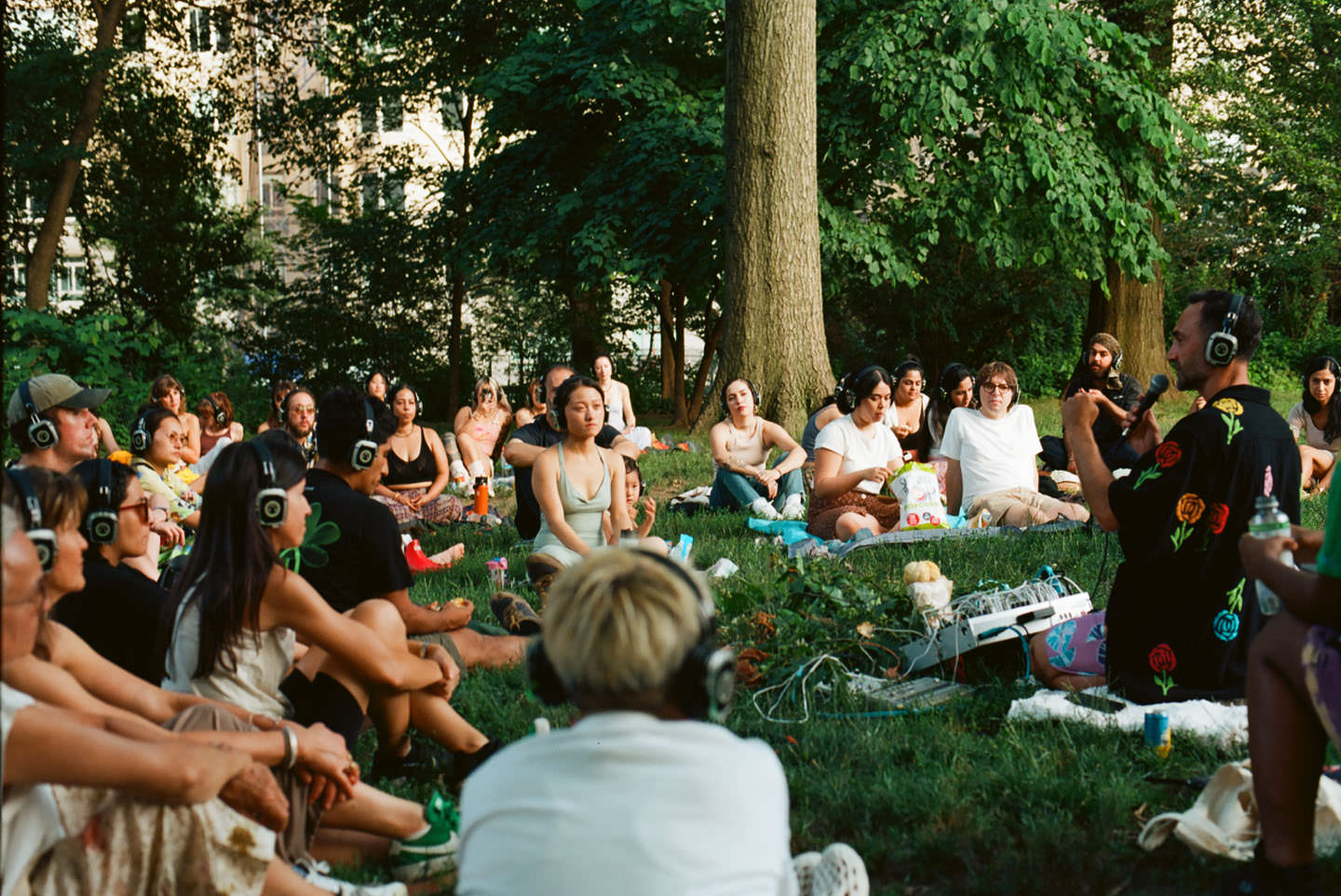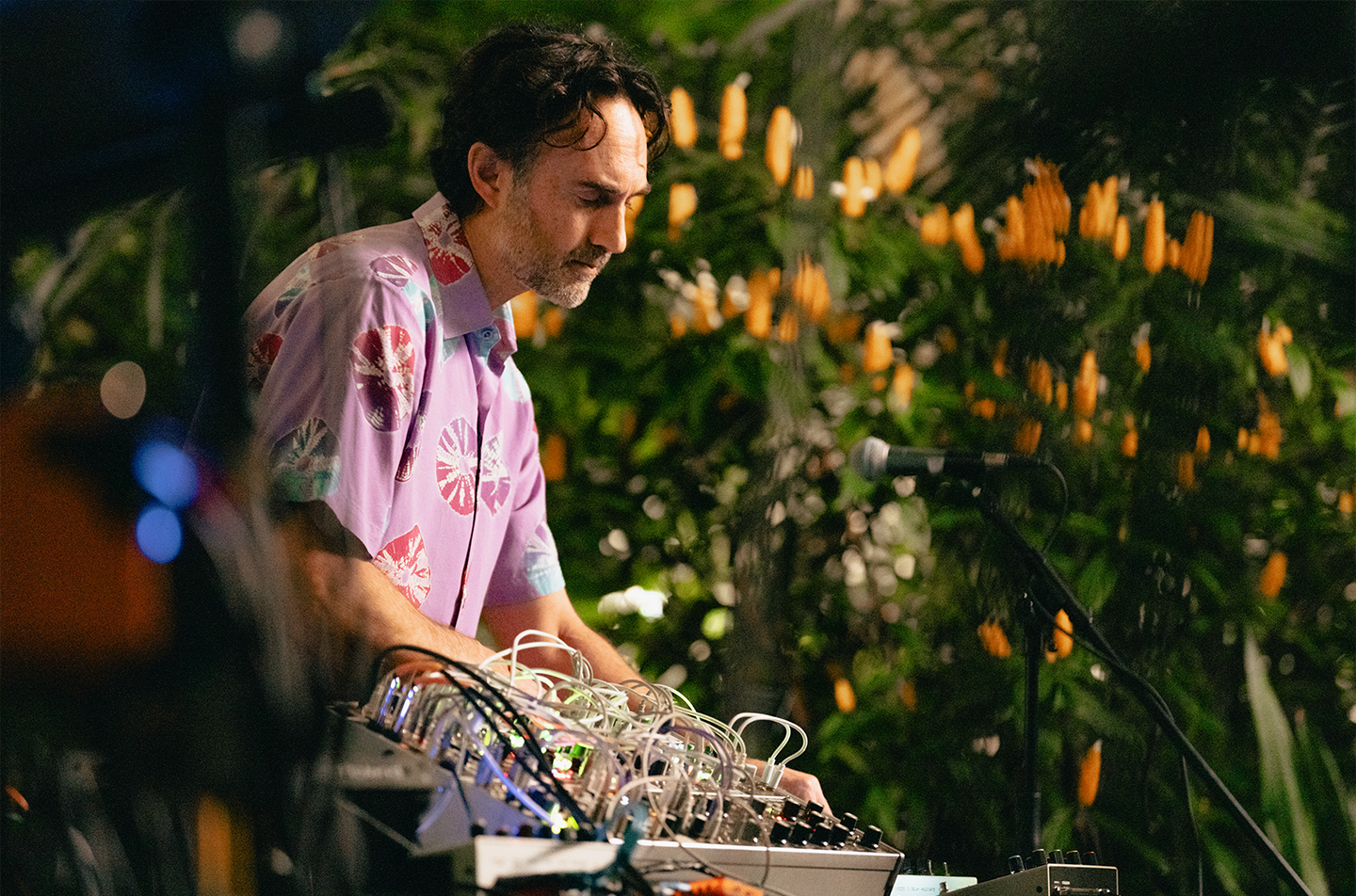In the cocoon-like interior of the restaurant Burdock & Co, headphone-clad diners focus intently on the plates before them. Forks pause midair between bites as people don’t just taste, they also listen to the food. I watch the gleam of neon-illuminated earcups—like blips on an amplifier—and tune in to the warbles emitting from a DJ setup, where a tangle of cables is plugged into a Buddha’s hand citron.
Behind the deck is Tarun Nayar, the Vancouver-based musician known as Modern Biology. He’s performing here for the first of a new series of Taste Sound dinners. Tonight, the theme is “Citrus-Scented Rain Under a Snow Moon,” a sensory meld of electronic and organic that’s a collaboration between Nayar and Andrea Carlson, the chef-owner of the Michelin-starred restaurant.

Nayar plugs into mushrooms in Topanga, California. Photo by Michael Muita.
As I sample each dish, Nayar plays ambient music that is textural, moody, atmospheric—a trippy translation of the plant ingredients’ bioelectricity. The Buddha’s hand is murmuring. The Japanese sudachi fruit is singing. Kind of. Nayar is channelling their fluctuations of energy—via electrodes and clips attached to the fruit—into a sonic composition at the intersection of music and biology.
The latent life force of the diminutive sudachi sphere is literally amplified in Nayar’s interpretation of its electrical currents. And its yuzu-like flavour intensifies in my mouth. This link between the senses goes back to the memory-inducing smell and taste famously wrought by Proust’s madeleine taken with tea, but recent research reveals that sound also affects taste. The work of Charles Spence, an experimental psychologist and author of Gastrophysics: The New Science of Eating, shows how different frequencies and volume influence taste—findings demonstrated tonight by Nayar and the sudachi’s twang and tang.
After the citrus soundscape at Burdock & Co, I meet Nayar in the Bloedel Conservatory, where he’s planning a live recording that includes the renowned Vancouver jazz multi-keyboardist Chris Gestrin. We sit on a bench amid the lush, teeming life and cacophony—including a pair of green-winged macaws perched behind us. Their squawks and trills punctuate our conversation as my glasses fog up in the humid environment of 500 plant varieties that include rare cycads and a corpse flower.

Photo by Hannah Paye.
“I’m definitely going to plug into one of the cycads,” Nayar says. “It’s a really ancient form of plant. They look a lot like palms, but they much predate the palms. And one of the interesting things about cycads is they actually have motile sperm.” He shares another wild factoid: pea plant roots will grow toward the sound of water coming from a buried speaker. “This whole world,” he notes, “is listening.”
He’s been scouting the tropical dome (wearing a graphic tee that says, “I believe in the power of plants”) with what he calls a sketch pad for music (a portable groove-box that samples, sequences, synthesizes, records), putting together short tracks to get into “the vibe of this place.” He hands me his headphones to listen to bleeps and beats that blend in with the screeches of the macaws and underlying purr of this jungle.
That vibe—a word often repeated by Nayar—is an amalgamation of the sighs and hums that ripple throughout the plant and fungus kingdom. “I’m taking electrical qualities of plants and mushrooms and using devices that turn that into information that synthesizers can use,” he explains. “It’s biosonification. It’s not like the mushroom is making a sound. The mushroom is being electrical.” Raw electrical signals or biorhythms are transformed into something audible to human ears. “Once the pulses are going, I take a lot of artistic licence and try to make musical compositions with it.” He does this by improvising and adding delay, reverb, and other effects with a custom setup of modular synthesizers—connected by those cables resembling vines or mycelia and plugged into living plants.
Nayar has composed music with a wide range of plants, from that Buddha’s hand at Burdock & Co to a honey locust tree in VanDusen Botanical Garden. But the first plant he plugged into was a salmonberry. While he was living in the Gulf Islands during the pandemic, his creative curiosity was sparked when a friend came by with a biosonification device. They routed the plant’s fluctuating electricity into a piano synthesizer. “As soon as I heard that salmonberry plant playing a piano, I was, like, ‘I’m in,’” Nayar says. “I just think it’s the coolest thing ever to be able to bring nature, living nature, into a musical composition.”
The biosonification device used to do this is akin to a modified polygraph machine, Nayar says. “It’s like a Grade 6 science project. It’s not crazy science like splitting atoms,” but it’s also on the frontier of fascinating research in botany and mycology. He cites SPUN (Society for the Protection of Underground Networks) and Michael Levin (a leading researcher in the “cognitive glue” of bioelectricity), as well as John Cage and Brian Eno (pioneers of generative music) and Sam Cusumano (an engineer and the creator of the first commercial biosonification device in 2012). Even a century ago, Sir Jagadish Chandra Bose, who Nayar calls India’s Einstein, laid the groundwork for plant neurobiology and invented instruments to detect plant signals.
A clip of Nayar plugging into an ink cap mushroom generated 25 million plays on TikTok and was reposted by rapper Big Boi of Outkast.
Educated as a biologist himself, Nayar moved to Vancouver about 25 years ago to pursue a master’s degree in oceanography. But his career morphed into professional music from performing as a DJ to co-founding the popular band Delhi 2 Dublin and playing high-profile venues including Glastonbury and Burning Man. Now biosonification has reconnected Nayar to his academic roots. “It’s kind of a dream come true,” he says. “I can approach it as an artist, but I understand the science.”
As an artist, he began playing the tabla drums at seven and trained in classical Indian music. “That’s the musical language I know best, so that’s how I see the world,” he explains. It’s improvisational, less constrained by chords and horizontal harmonies, and grounded in natural rhythms with ragas (melodic frameworks) for specific seasons and times of day. Tabla players may try to sound like a deer or bird and even perform a raga to summon rainfall. On his first Modern Biology album, Plant Music, Vol. 1, tracks have ragas such as “Swordfern in the Morning (Raag Bhairavi)” or “Fairy Creek Alder in the Evening (Raag Kafi).”

Listeners at a field trip in Central Park, New York. Photo by Hannah Paye.
That alder track is inspired by the Fairy Creek old-growth forest on Vancouver Island, using sprigs brought to Nayar by people who protested logging there in 2020 and 2021. It was around the same time he went viral. A clip of Nayar plugging into an ink cap mushroom generated 25 million plays on TikTok and was reposted by rapper Big Boi of Outkast. Nayar gained 160,000 followers—including celebrities such as Pharrell—overnight.
Since then, he’s become part of the zeitgeist obsessed with mycology, from the rise of psychedelics to the fungi-dominated world of The Last of Us. Nayar identifies it as “this feeling that we’re kind of fermenting as a civilization,” while underground is the “brilliantly flexible way of life” of mushrooms and mycelia.
These fungi reveal a totally different approach to living when, as Nayar says, “our world is in need of a little recomposition.” In our Anthropocene era, he wants to help people reconnect with nature and protect wild places, old-growth forests, and intact ecosystems such as Fairy Creek. Through immersive events—from the botanically themed Taste Sound dinner at Burdock & Co to a Mushroom Church performance in the historic De Duif church in Amsterdam—he prods humans to commune with plants. He’s brought together people in parks on “field trips” and in concerts from Berlin to Bangalore and performed at Art Basel Miami and the Nobel Prize Museum in Stockholm.
“It’s not only music. It’s also a little bit of science and a little bit of spirituality,” he says. And he wants this music to be more than a gimmick. “If I lend anything to the discussion, it’s probably popularizing it, and also thinking about formats in which it can be presented and land with people and not just be a weird thing on the side. I actually think it can be a focal point of a really profound musical, emotional, and spiritual experience without being woo.”
By tapping into the Earth’s resonant hum—or vibe, in his parlance—as an artist-cum-scientist who crosses disciplines and collaborates with other creatives, innovators, and provocateurs—musicians, poets, visual artists, scientists, chefs—he offers a visceral way into a vast and otherwise unfathomable ecosystem.
“You don’t need a bunch of flashing lights and cables to find a relationship with the land,” he says with a smile. “But I’m a nerd with synths.”
Read more from our Summer 2025 issue.









